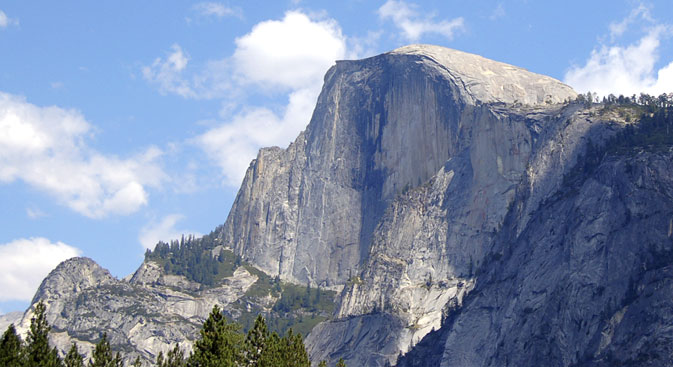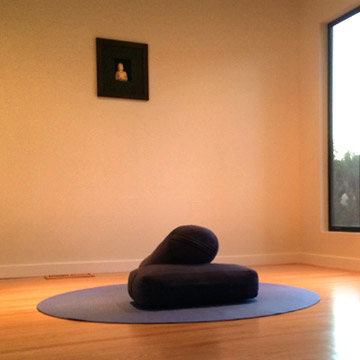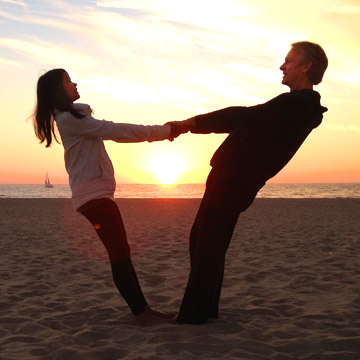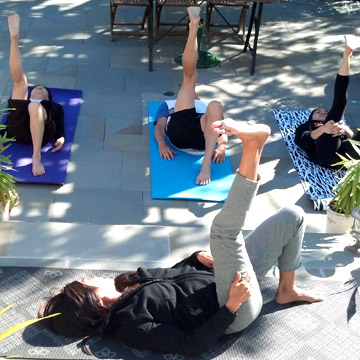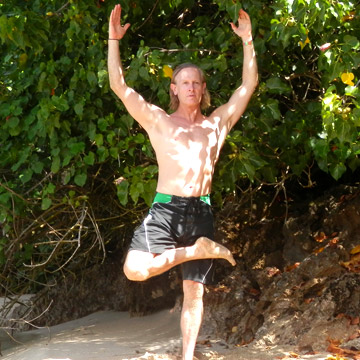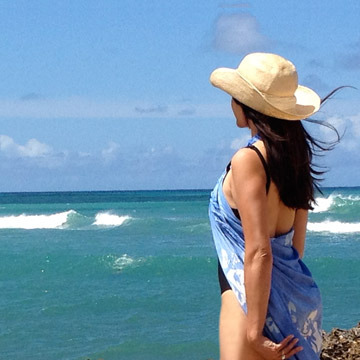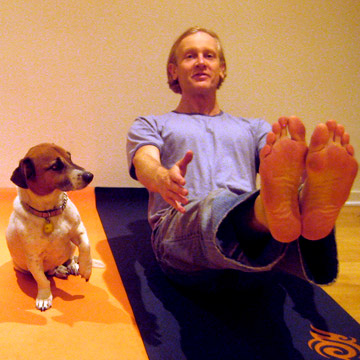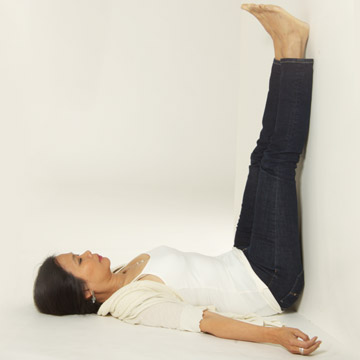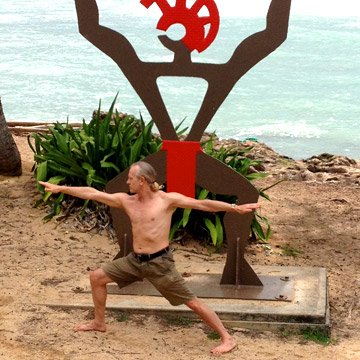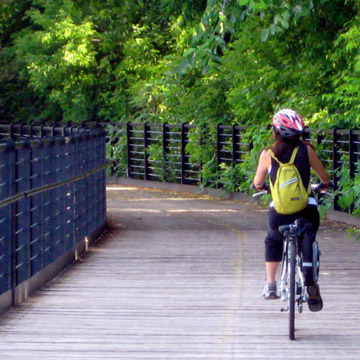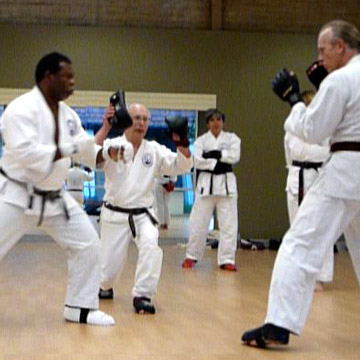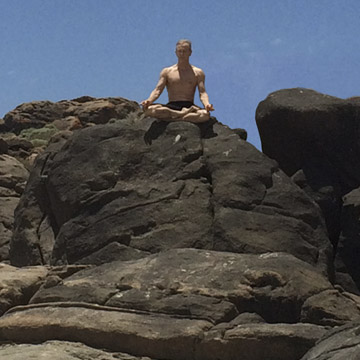Pose of the Month — Tadasana (Mountain Pose)
It's hard to choose a favorite but Tadasana is one pose that has a profound effect. It connects on several levels — the psychical and metaphysical. On a physical level it re-establishes or corrects our posture, helping to undo all of the forward bending done throughout the day — working on the computer, drawing, gardening, building, driving, watching TV, cooking, even on the toilet. It's amazing how much of a lean-forward society we have become. Yet the natural design for the spine is extension, the opposite of foward bending which is flexion.
Mountain pose also provides a magnificent sense of calm and strength. There's a strong connection to the earth with your feet through the "eye of the soul", and it connects us to the universe above, through the crown of our head, (2 energy gateways in Chinese medicine and Yoga). Imagine zooming-out, as though viewed from a distant galaxy — see yourself becoming smaller and smaller, still rooted to planet earth but connected to all around you. As Dr. Rick Hanson explains: by simply being with the feeling, taking time to fully absorb it, and focusing on the benefits of the sensation, we can hard-wire that sense - in this case calm and strength, into our nervous systems.
It's a fantastic position for meditation, especially in the mornings as the sun rises in the East, the sun's rays touching our skin feeling a sense warmth, of awakening and welcoming, or perhaps washing-away past negative thoughts, and replacing them with positive thought loops. Also, at noon with the sun directly above us we can re-visit our desires and train the mind to keep sharp — avoiding distractions with longer periods of focus and concentration. For more tips on meditation see: Meditation as a Symphony
The Foundation
Our poor toes! It's as though shoe designers had conspired to injure, compress, and deform our lower extremities. They're too often crammed into narrow, cramped shoes.This can lead to Capsulitis — inflammation of a joint capsule. Ligaments surround your joints, including your toe joints, and help form a capsule. Joint capsules help your joints to function properly. Capsulitis is common in your tootsies and your shoulders.
Most shoes have elevated toe boxes, as a built-in design feature. Toe box elevation increases pressure under the capsules of your toe joints. Because your second metatarsal bone is usually the longest in your foot, it performs more than its normal share of weight bearing, and it can become inflamed and painful. Tapering toe boxes is another problematic design feature built into most footwear, and another factor contributing to capsulitis. Tapering toe boxes force your big toe against your second toe, putting your big toe out of balance with its corresponding metatarsal bone.
Some Relief and Preparation for Tadasana
In a comfortable seated position, (you can do this in a chair or on the floor). If you're on the floor, I suggest some elevation to raise the hips allowing deeper access into the feet. If you're on a chair, move towards the front of the chair. Remove your socks and place your palm at the ball of your foot. Begin to work your fingers between your toes, as deep to the toe-webbing as possible. Spread the fingers wide bringing both toes and phalanges into flexion. Repeat on other side.
At the Wall
Tadasna is a wonderful standing meditation. It also impacts our psychical, anatomical alignment creating less stress on the body, especially the spine, neck and shoulders. We can retrain our neural network to stand in a position that provides the most amount of peace in your spine — a natural and neutral alignment, helping to avoid kyphosis, anterior head carriage, dowager's hump, and other spine ailments caused by the effects of aging.
Find a wall and place your heels about an inch away from the base board, try to place your posterior (aka bum or butt) and the back of your head against the wall. Try not to pronate the chin, draw the chin to the horizon line if it's pointing up towards the sky. In yoga and martial arts we start with the feet — our foundation. Spread your toes wide, feel the air between the webbing of your toes. Feel your feet firmly into the earth. Firm your thighs so much so the kneecaps rise. Imagine each vertebrae stacked directly on top of each other as you send the breath slowly up the spine disk by disk. Visualize (from a profile view) the alignment of ear in line with shoulder, aligned with hip, knee and ankle — the perfect anatomical plumb-line.
Glance down at your feet and notice any misalignments or gripping, lift your toes up, and at the same time shrug your shoulders to your ears. Spread your toes wide and re-root into the ground as you relax your shoulder blades back and down. Soften jaw, turn your palms slightly forward. Try thinking from the feet up rather than from the head down. This helps us stay out of our busy minds and coming deeper into sensation.
Visualize
I invite you to visualize a progress meter. Starting at your feet, breathing quietly in and out of the nose, send a breath up through the back body to the ankles, then up to the knees, (25 percent of your progress meter fills) then take another slow deep breath and send the exhale up to the hips, (50 percent) then to the shoulders (75 percent) up the neck to the crown of the head and beyond — 100 percent of your meter filled, (also see: What we consider to be the boundary of ourself). Witness sensations: tension, clenching, tightness, or ease. Welcome sensations and attune to your body. Note the quality of your breath. Take a nourishing inhale and direct the exhale up the spine to the crown of the head. Take a few nourishing breaths here standing tall. Try sending the exhale in the opposite direction at the same time — up through the crown of the head and down the spine to your tailbone. Feel the spine unfolding, opening spaces between the vertebrae — sense getting a little taller.
You can add a mantra here too if you like — it's a nice positive thought loop. Repeat three times: "I am calm, I am strong", after all it is "Mountain" pose.
After 2-5 minutes — longer if possible, move away from the wall and notice how different it feels. See if you can maintain this feeling of Tadansana throughout your day.
You can retrain the mind to this new posture, (the mind is incredibly "plastic" aka neuroplasticity) and when accompanied with other chest-opening exercises it will reverse anterior head carriage/kyphosis. Neuroplasticity is activated through repetitive practice. Whatever you repeat over and over and over is what your mind and body gets skilled at.
Namaste
By John & Mary Jo Johnson, (C-IAYT)
